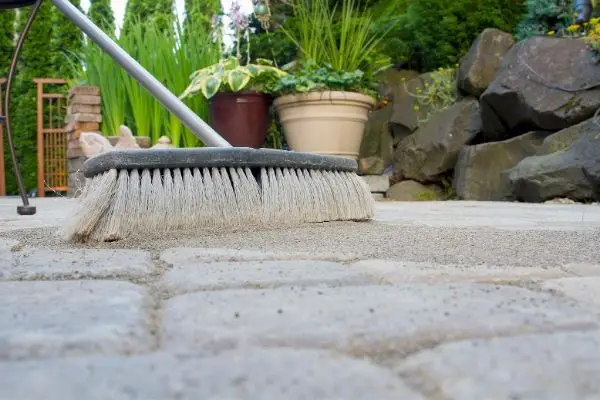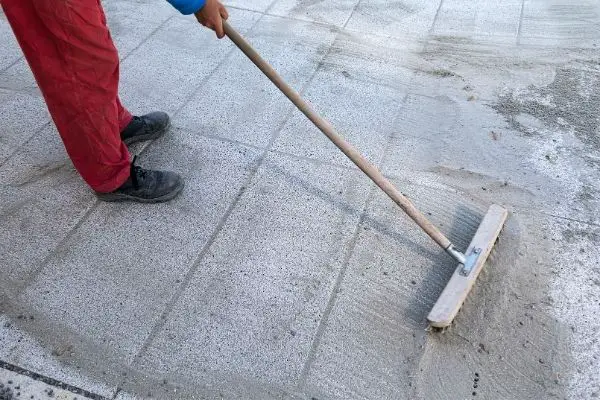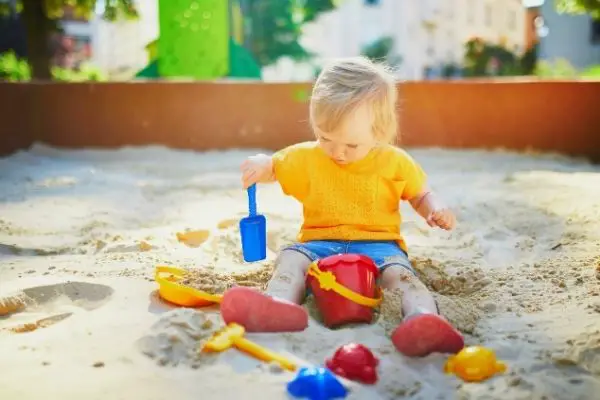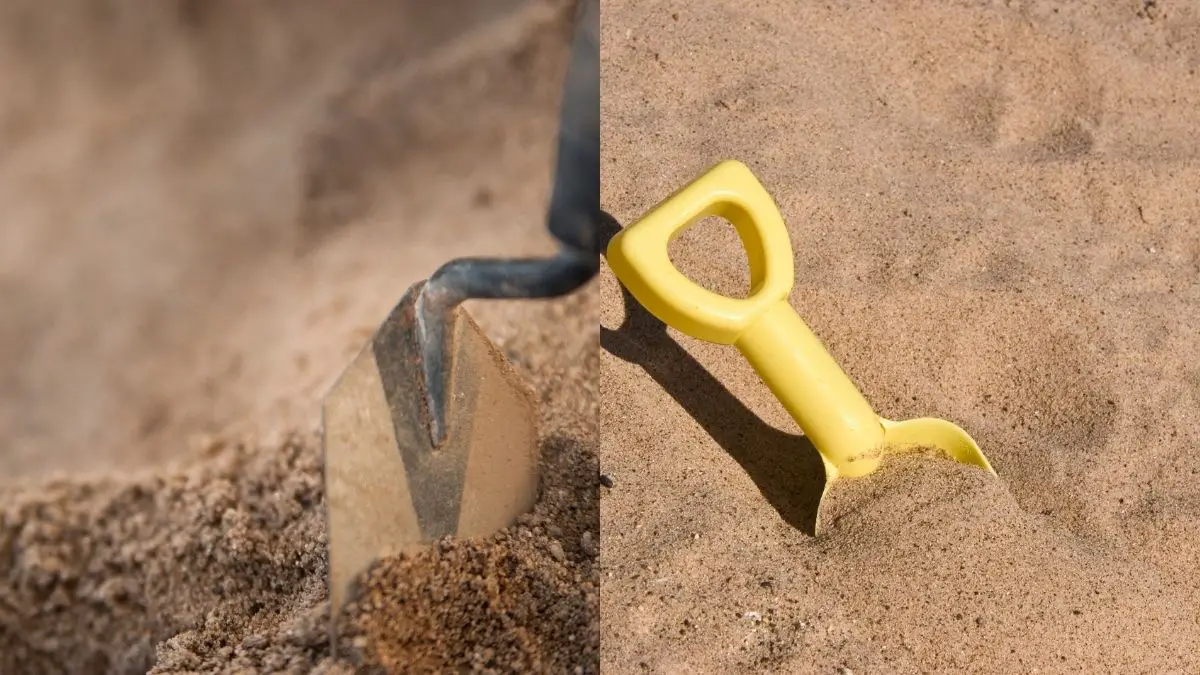Paver Sand vs Play Sand: Why Using The Right Sand Is So Important
Sand is sand, right? Actually, no! After I found out that some commercial sand may contain traces of tremolite – a type of asbestos – I have been very careful when choosing the best sand for my kid’s sandbox!

When it was time to do some garden maintenance, I was intrigued about paver sand alternatives! Of course, as opposed to my kid’s sandbox, my children are less likely to be digging and hiding paver sand in their pockets. But, with kids, you never know!
When it comes to choosing the right sand for a home project or filling a sandbox, the type of sand you choose can make a huge difference!
Paver sand and play sand are two of the most popular types of sand available. It’s important to know the difference before using either one around your home.
Let’s explore the key differences between play sand vs paver sand, including which is the safest option for your specific needs.
What Is Paver Sand?

Pavers are a great way to add a walkway, patio, or another form of hardscaping to your backyard. But if you want your pavers to stay in place and have a finished look, you need to fill in the gaps (known as joints).
Paver sand is the material of choice for filling joints between pavers. It features large, coarse particles that provide plenty of friction to lock everything in place.
What Is The Best Sand To Put Between Pavers?
The most important factor in choosing high-quality paver sand is the coarseness.
You can find paver sand sold under many different names, including all-purpose sand, joint sand, and levelling sand.
Another type of paver sand you might encounter is polymeric sand. This works great for securing paver joints but it is not the same as regular sand.
There are different brands of sand for pavers to suit all budgets and needs.
What Is The Difference Between Polymeric Sand And Regular Sand?
Polymeric sand is a specialty product containing regular paver sand mixed with water-activated bonding agents. When these chemical agents are activated, the polymeric sand forms a hard, gel-like bond.
Polymeric sand is popular because it creates a durable joint between paving stones, locking everything in place. It also offers protection against weeds and insects that may try to come up through the joints.
How Long Does Polymeric Sand Last?

Once installed, polymeric sand is permanent. But, as with all landscaping and home improvement projects, that doesn’t necessarily mean it will last forever.
Most homeowners can expect their polymeric paving joints to hold up for at least five years with minimal maintenance. You can reapply polymeric sand as needed to fill cracks or damage.
Does Water Drain Through Polymeric Sand?
Polymeric sand does allow some water to pass through. However, it is not entirely permeable. A well-designed walkway or patio should allow water to run off for proper drainage, even if it is constructed with polymeric sand.
How Many Inches Of Sand Do I Need For Pavers?
The standard recommended depth for paver sand is one inch. This offers enough material to grip each paver stone in place and provide a level finish.
Please note that this depth can vary greatly depending on the project and the type of ground you’re starting with. If you’re unsure how much paver sand you need for your project or how to pack sand for long-lasting results, we recommend consulting with a professional.
What Is Play Sand?

As the name implies, play sand is designed for play. The most common use for this type of sand is in children’s sandboxes. Like most sand, play sand is made primarily of quartz.
Play sand is very fine, making it more comfortable to work with. This also makes it easier to mold and sculpt, which is a must for the perfect sandbox experience!
Perhaps the most important feature of play sand is that it is processed specifically with children’s safety in mind. This is not the case for sand manufactured for landscaping or construction.
Why Is Play Sand So Dusty?
Play sand is one of the finest types of sand commercially available. While this fineness makes play sand great for playing around in, it also increases the amount of dust.
You can help eliminate dust in your child’s sandbox by keeping the sand slightly damp at all times. Invest in a sandbox with a secure cover to keep the sand clean and from drying out.
Another reason sandboxes tend to be quite dusty is because the sand particles settle over time. Sifting through the sand once a week will prevent larger particles from sinking to the bottom (and, as a result, smaller particles sitting on the surface).
Is Play Sand Really Safe?
As a parent, I worry about the things my children are exposed to on a day-to-day basis, knowing that their hands easily and regularly go from toys (sand included) to mouth. So it makes sense that you’d wonder about the safety of letting your child play in a box full of sand.

One common concern about play sand is whether or not it contains silica dust.
While play sand often contains crystalline silica (it is a byproduct of the quarrying process), there’s no evidence that the concentration is high enough to cause harm.
It’s also important to note that silica is found in natural sources like beach sand.
Ultimately, it’s up to each parent to decide if traditional play sand is right for their family.
Because of the concern surrounding play sand and silica particles, demand has grown for silica-free play sand products. Same great alternatives for sandbox alternatives for sand include Safe Sand, Jurassic Sand and Sandtastik.
Frequently Asked Questions
What is mason sand?
While the two are very similar, mason sand is not just another name for paver sand. And it’s important to know the difference before you try using this type of sand in one of your own DIY projects.
Mason sand is processed to a much finer consistency than paver sand. This gives a smooth, aesthetically pleasing finish for applications like brick mortar. However, it’s more likely to shift and wash away than coarse paver sand.
How do you seal sand between pavers?
If you’re wondering how to keep your paver sand from just washing away during heavy rain, the answer is to apply a sealant.

Applying a layer of sealant will ensure your pavers look their best. It will also act as a glue to hold the sand particles together.
Even if your patio or walkway is protected from rain, sealing the joints will keep your pavers from shifting over time.
Is paver sand safe for a sandbox?
While some paver sands might be safe for use in a sandbox, it’s best to steer clear.
When you compare paver sand vs play sand, the biggest difference is that paver sand doesn’t undergo the same testing to ensure it’s child-safe. In other words, you have no way of knowing if the sand contains any harmful chemicals or is unhygienic.
We always recommend using specialty play sand for the safest sandbox possible.
Can you use play sand between pavers?
If you’re looking to save a few bucks on your landscaping project, you might be tempted to use cheap play sand between your pavers. But this won’t get you the uniform, long-lasting results you’re looking for.
Play sand is quite fine, especially when compared to masonry and paver sands. It will quickly wash away after installation, leaving you with empty joints and uneven pavers.
What can I use instead of sand in a sandbox?
Creative parents are constantly coming up with new fillers for their children’s sandboxes. Some popular alternatives to sand include pea gravel, rubber sand, styrofoam, and even uncooked rice.
Remember that each of these materials comes with a unique list of pros and cons. Do your research before swapping out your current play sand for one of these alternatives, and always supervise children when playing in a sandbox.





